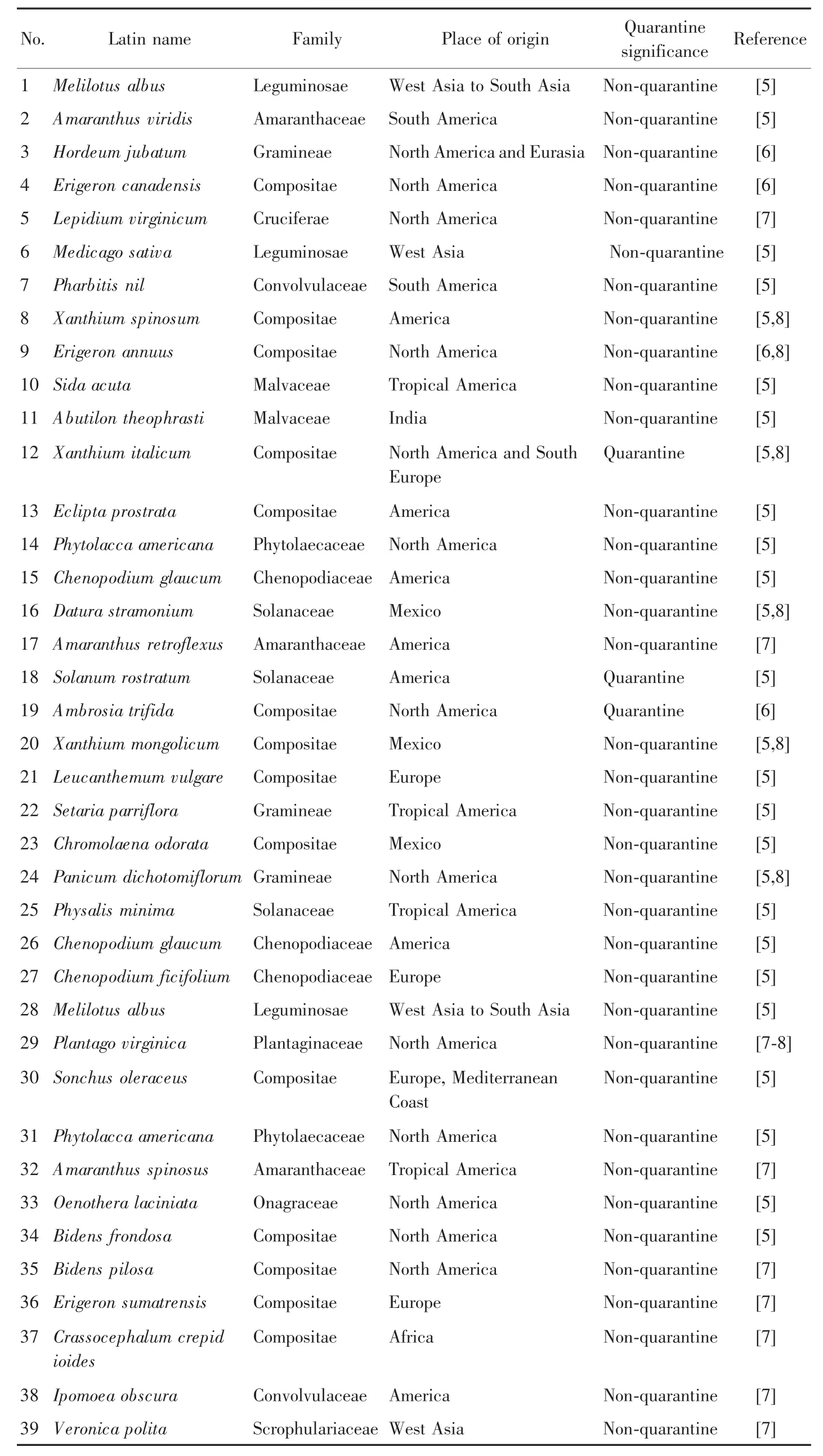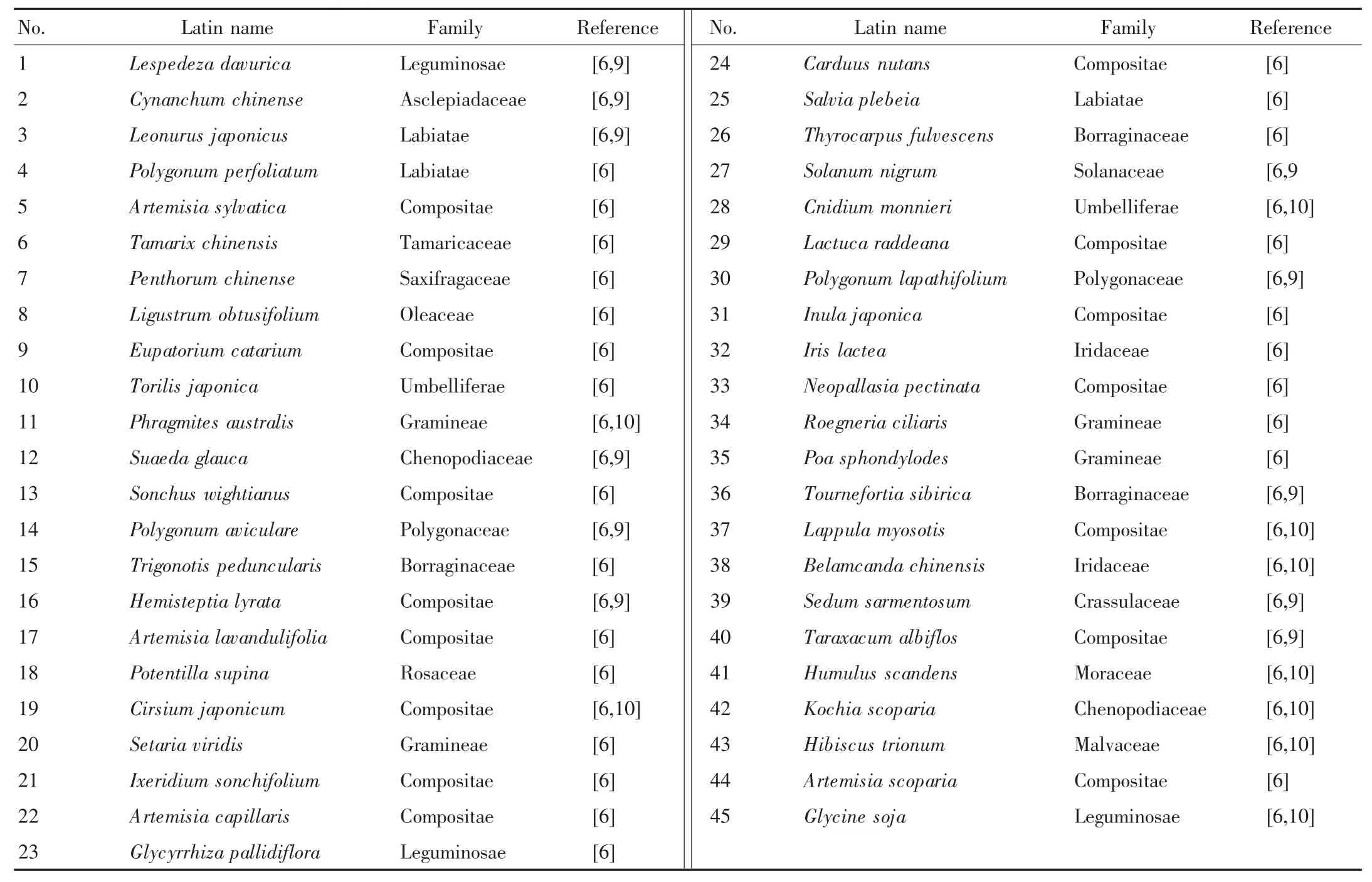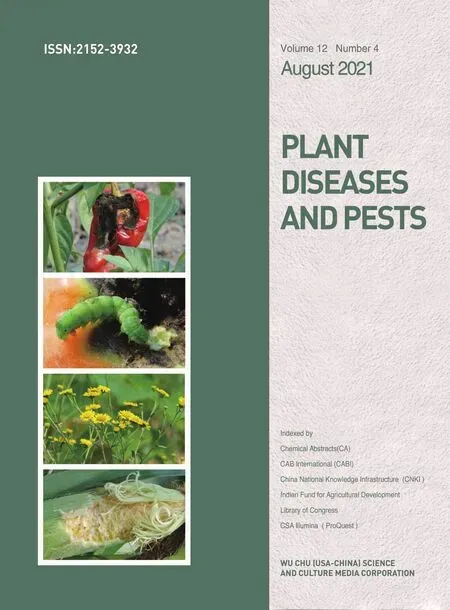Preliminary Investigation and Analysis of Alien Pests at Panjin Port
2021-02-26YajinZhaoXiaofeiSunYangLi
Yajin Zhao,Xiaofei Sun,Yang Li
Dalian Customs,Dalian 116000,China
Abstract[Objective]The paper was to understand the current situation of alien species at Panjin port,and provide the reference basis for the development,construction and management of Panjin port.[Method]The species,life forms and habitats,place of origin and invasion mode of alien pests at Panjin port were studied by the way of route survey,combined with literatures and molecular biology methods. [Result]A total of 137 species of weeds and insects were preliminarily identified at Panjin port.There were 84 species of weeds belonging to 25 families,39 of which were alien species and 3 were quarantine weeds.There were 56 species of insects belonging to 30 families,all of which were native to China.(i)There were 29 species of Compositae weeds,accounting for 35.8% of the total.(ii)Weeds were mainly annual and biennial.(iii)There were 24 species of weeds native to America,accounting for 61.5% of the total;followed by those native to Europe,with a total of 12 species,accounting for 30.8%.(iv)Weeds had poor growth,so there was no invasion,and they can be eradicated once discovered.[Conclusion]In the newly opened grain berths at Panjin port,it is suggested that all departments strictly check the pass,strengthen supervision and monitoring,scientifically introduce seeds,strengthen public education,raise public awareness,and improve the control system of alien pests.
Keywords Weeds;Insects;Investigation;Analysis
Panjin City,located in the center of Liaohe River estuary delta in the south of Songliao Plain,is marine outfall in northeast China and also the intersection of"three development strategies"in Liaoning Province.As a resourcebased transformation pilot city approved by the State Council,Panjin City is in the key period of"developing to the sea,strengthening the city with port and comprehensive transformation".Therefore,Panjin port and city linkage and new opening of grain berths will bring considerable economic benefits and social benefits for the development of Panjin,and Panjin port will also become the bridgehead of"north-to-south grain diversion"in northeast region.The implementation of the open policy provides development opportunities for ports,but at the same time,it also brings new situations and problems for quarantine work.Frequent material and personnel exchanges facilitate the introduction of alien species.When new species cross the natural geographical barriers and reach the invasion site,due to their biological characteristics and lack of natural enemies,they are easy to quickly colonize and cause serious biological invasion,which will cause irreversible loss and harm to local natural ecosystem,and the economic loss caused is immeasurable.This study is the first background investigation at Panjin port,and there is no investigation on alien pests at Panjin port.In this paper,the background investigation of alien pests at Panjin port was carried out by the way of route survey.Combined with literatures and molecular biology methods,the species,life forms and habitats,place of origin and invasion modes of alien pests at Panjin port were studied,and the investigation results were further analyzed.The background investigation aimed to find out the status of pest invasion at Panjin port,provide data support for the transformation and opening of Panjin port,and provide support for the prevention and control work in the future,so as to better deal with the introduction of alien pests.
1 Survey Methods
1.1 Survey scope The survey area was Panjin port and the surrounding area within 1 km.The main investigation points were granaries,grain transport channels,pond surroundings and peripheral roads.
1.2 Weed investigation and species identification
1.2.1 Survey methods.The investigation adopted four-factor schemes of fixed person,fixed point,fixed time and fixed method.According to the weed growth environment,the survey route was determined in Panjin port and the surrounding area within 1 km.During the investigation,weed image data were retained and geographic information was recorded.At the same time,plant specimens were collected in the investigation area.
1.2.2 Species identification.The weeds which were difficult to identify were examined by anatomy,microscopy and molecular biology.The collected samples were made into specimens by pressing,drying and other procedures.
1.3 Insect investigation and morphological identification
1.3.1 Survey methods.Arthropods and mollusks within the scope were investigated.Insect trap lamps were placed at fixed points by fixed person from 18:30 pm to 20:00 pm of the next day in March,May,July and September,three times each month,with a total of 12 times.Yellow sticky traps were artificially installed in March,May,July and September,three times each month,with a total of 120 traps.Sweet and sour liquids were artificially distributed in March,May,July and September,three times each month,with a total of 40 bottles.Malaise trap was artificially released in March,May,July and September,one time each month,with a total of 4 times[1].
1.3.2 Species identification.According to the traditional morphological characteristics of insects,the species of insects were identified by means of preliminary identification and validation.
2 Survey Results and Analysis
2.1 Survey results and analysis of weeds
2.1.1 Species composition of weeds.In this background investigation,84 specimens were collected,belonging to 25 families.Among them,45 species were native to China and 39 species were alien species.The 25 families investigated were Compositae(29 species),Gramineae(7 species),Leguminosae(6 species),Chenopodiaceae(5 species),Solanaceae(4 species),Labiaceae(3 species),Borraginaceae(3 species),Amaranthaceae (3 species),Convolvulaceae(2 species),Malvaceae(2 species),Phytolaecaceae(2 species),Umbelliferae(2 species),Iridaceae(2 species),Polygonaceae(2 species),Asclepiadaceae(1 species),Rosaceae (1 species),Plantaginaceae(1 species),Oleaceae(1 species),Moraceae(1 species),Cruciferae(1 species),Tamaricaceae (1 species),Saxifragaceae(1 species),Crassulaceae(1 species),Scrophulariaceae(1 species)and Onagraceae(1 species),respectively.
Alien and local weeds at Panjin port are shown in Tables 1-2.The results showed that 29 species of weeds at Panjin port belonged to Compositae,accounting for 35.8% of the total species.This family is a worldwide family because of its crested hair and easy transmission[2].However,Compositae still occupied a large proportion of weeds in Panjin area,which might be related to saline-alkali soil conditions in Panjin area;followed by Gramineae(7 species),accounting for 8.6% of the to-tal;Leguminosae (6 species),accounting for 7.4% of the total;and Chenopodiaceae(5 species),accounting for 6.2% of the total.

Table 1 List of alien weeds at Panjin port

Table 2 List of local weeds at Panjin port
In this investigation,3 quarantine organisms were found,namely Xanthium strumarium,Solanum rostratum and Ambrosia trifida,all of which were in the list of 41 quarantine weeds published by the Former Ministry of Agriculture and the General Administration of Quality Supervision,Inspection and Quarantine of the People’s Republic of China in May 2007.However,only one plant of three quarantine organisms was detected respectively and had been eliminated in time,so no harm was caused to agriculture and ecology temporarily.
2.1.2 Life form and habitat.Through the investigation of Panjin port,it was found that there were less species of weeds,and most were alkali plants with saline-alkali and barren tolerance,with low coverage,and the proportion of bare soil area was larger.
The alien weeds at Panjin port were all herbaceous plants,most of which were annual or biennial herbs,and only Datura stramonium was perennial plant.It can be seen that the alien weeds at Panjin port were mainly annual or biennial herbs.Panjin port has the natural condition of saline-alkali land,and herbaceous living plants are easier to invade and spread because of strong environmental adaptability and short life cycle[3].Meanwhile,compared with perennial herbs,shrubs,trees and lianas,herbaceous plants have a large number of seeds,which are small and light,and are easier to spread by external forces such as wind and water power[4].
The survey results demonstrated that alien weeds did not form growth advantages,and such weak alien weeds might be the result of survival and reproduction in a suitable environment after the seeds dropped by grain and oil enterprises when they entered and left the storage,but they did not form good growth due to environmental and time factors.
2.1.3 Analysis of place of origin.The alien weeds at Panjin port were native to America,Asia,Europe,Africa and other regions.There were 24 species of weeds from America,accounting for 61.5% of the total alien weeds.There were 12 species of weeds from Europe,accounting for 30.8% of the total alien weeds.There were 3 species of weeds from Africa,accounting for 7.7% of the total alien weeds.Therefore,the alien weeds at Panjin port were mainly from America.
2.1.4 Analysis of invasion mode.There are three invasion modes of alien organisms:natural diffusion,artificial introduction and human activities[11].Natural diffusion is the instinct of species,and alien species ultimately rely on their own diffusion ability to complete the invasion.However,the natural diffusion of species is often restricted by ecological stability,spatial barrier and other factors,and it is difficult to achieve long-distance transmission.Therefore,artificial introduction and related human activities become the main way of species invasion[12].
It was found that there were 39 species of alien weeds at Panjin port,but each species of weeds was not abundant and did not grow well.It may be because the grain business at Panjin port just started,and there have been no cases of plant invasions caused by artificial introductions or inadvertent introductions through freight.
2.2 Survey results and analysis of insects
2.2.1 Composition of insect species.A total of 56 species of insects,belonging to 30 families,were captured in this background survey,including Coeeinellidae(6 species),Carabidae(4 species),Tabanidae(4 species),Pyralidae(4 species),Aphididae(4 species),Culicidae(3 species),Pieridae(2 species),Cicindelidae(2 species),Rutelidae(2 species),Calliphoridae(2 species),Sarcophagidae (2 species),Noctuidae (2 species),Melolonthidae(2 species),Chrysopidae (1 species),Crambidae (1 species),Pentatomidae (1 species),Tipulidae(1 species),Pseudococcidae(1 species),Drosophilidae(1 species),Colydiidae(1 species),Acrididae(1 species),Reduviidae (1 species),Syrphidae(1 species),Cerambycidae (1 species),Cicadellidae (1 species),Chrysomelidae(1 species),Formicidae(1 species),Anthicidae(1 species),Galerucidae(1 species),and Cecidomyiidae(1 species).
No invasive insects were found within 1 km of Panjin port and its surrounding area(Table 3).

Table 3 List of insects at Panjin port
2.2.2 Survey and analysis of insects.The 56 species of insects in this survey were all native to China,and no alien species were found.Coeeinellidae accounted for the largest proportion of only 10.7%,and other insect species were scattered without species aggregation.
3 Discussion
Although alien invasive weeds can spread relying on natural factors such as wind power,human factor is the most important factor.For example,about half of alien harmful plants are directly caused by irrational introduction,while alien invasive insects are mainly introduced by unintentional human behaviors,mostly due to human activities,which are introduced and then spread along with transportation vehicles and goods[13].Therefore,in order to prevent the invasion of alien pests,it is necessary to strengthen the control of artificial introduction and unintentional introduction.In terms of artificial introduction,customs,agriculture,forestry and other government departments should strictly check the approval of introduction,carry out scientific risk analysis,and achieve scientific introduction[14].Besides,they should strengthen the management of species after introduction to prevent alien species from escaping from cultivation and domestication land to the natural environment and evolving into invasive species.In terms of unintentional introduction,public education should be strengthened to raise public awareness,and the knowledge of alien species invasion and inspection and quarantine should be widely publicized to improve the national awareness of prevention.Moreover,strict inspection and quarantine should be carried out to block the possibility of unintended introduction as much as possible[15].
Therefore,it is necessary to strengthen the prevention consciousness of enterprises and the masses at ports,and vigorously publicize the harm of alien invasive species and raise people’s awareness of prevention. Meantime, the large-scale spatial analysis of alien species invasion and early warning research of invasion trend should be done to grasp the invasion trend from the macro and determine the key factors affecting the invasion,so as to better predict and prevent the occurrence of ecological invasion.
杂志排行
植物病虫害研究(英文版)的其它文章
- Discussion on Fresh Agricultural Products Ordering and Preservation Strategy under New Normal Carbon Emission Constraint
- Green Prevention and Control Technology of Pests in Cotton Fields in Shandong Province
- Green Prevention and Control Technology against Main Diseases and Insect Pests of Facility Tomato
- Key Points of Prevention and Control Technology against Pear Powdery Mildew
- Mechanism and Application of Plant Rhizospheric Bacillus sp.for Growth Promotion and Disease Prevention
- Bioactivity Determination and Control Effect Evaluation of Three Plant Secondary Metabolites against Semiaphis heraclei
